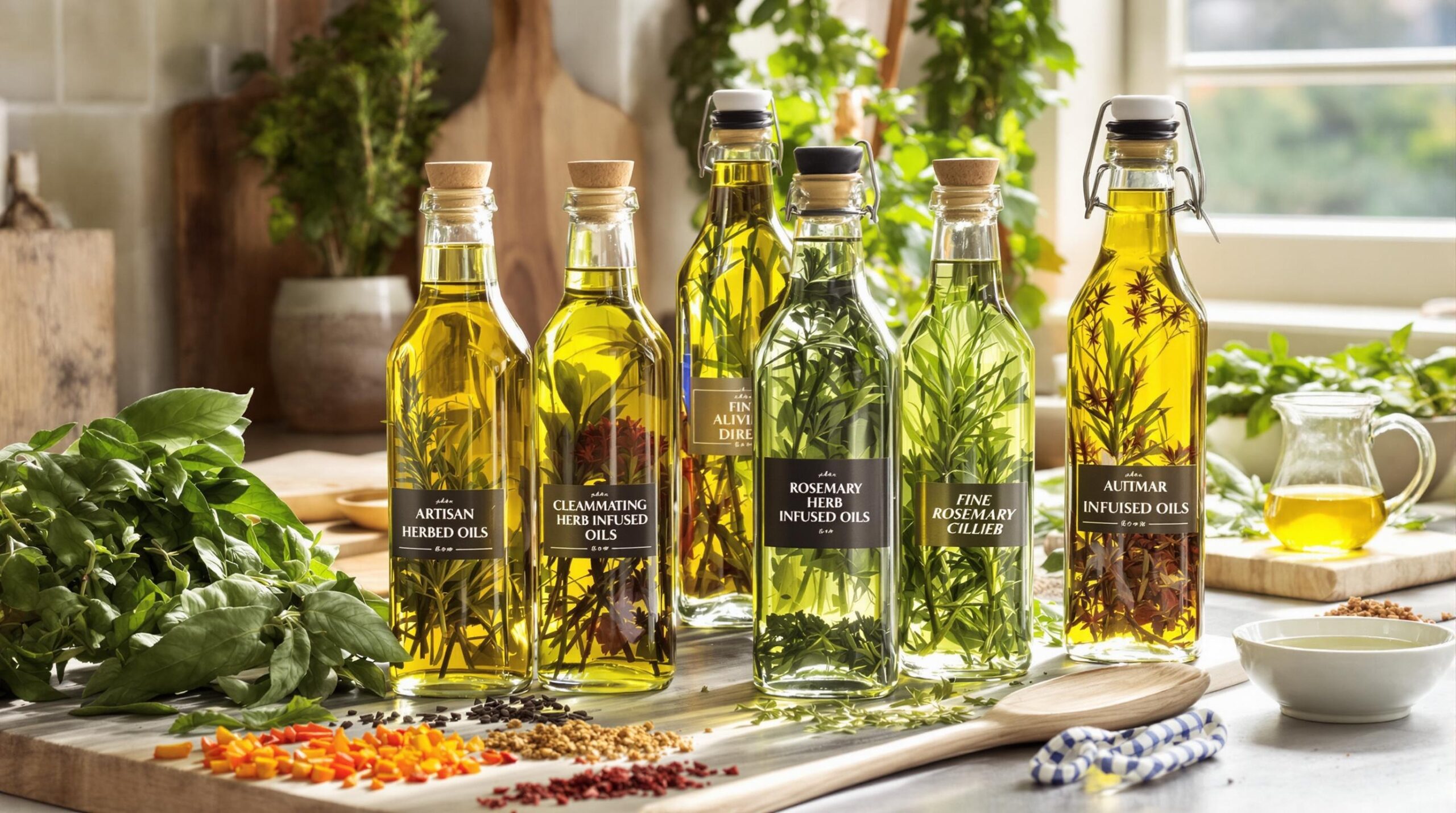Homemade herb-infused oils are versatile culinary ingredients and have become household favorites. Infusing oils at home allows individuals to experiment with flavors to enhance their meals. This guide explores the process of creating herb-infused oils and delves into their culinary applications and benefits.
Understanding the Art of Infusion
Infusing oil with herbs is a simple yet transformative technique and enriches the oil’s flavor, aroma, and color. During infusion, flavors and aromas from herbs are extracted and blended into the oil. This process enhances the oil and captures the essence of fresh herbs within.
Choosing the Right Oil and Herbs
Selecting the appropriate base oil is the first step in crafting a flavorful herb-infused oil. Olive oil, known for its robustness, is a popular choice for many. It harmonizes well with herbs such as rosemary, thyme, and sage. Alternatively, lighter oils like grapeseed and sunflower subtly accompany delicate herbs like basil and chervil.
Freshness is crucial when selecting herbs for infusion. Fresh herbs impart vibrant flavors and aromatic compounds to the oil, making them essential components. Thoroughly wash and dry the herbs, ensuring no moisture remains, as water can spoil infused oils quickly.
Creating Herb-Infused Oils
Success in crafting infused oils hinges upon precision in the infusion process. Begin by gathering clean, sterile glass jars and filling them with finely chopped herbs. Pour the oil over the herbs, ensuring they are fully submerged, which helps extract maximum flavor.
The Infusion Process: Heat Infusion vs. Cold Infusion
Two primary methods exist for infusing oils: heat infusion and cold infusion. Each technique offers unique advantages and results in different flavor intensities. The heat infusion method involves gently warming the oil with herbs, encouraging the infusion process. Heat aids in releasing essential oils and flavors from herbs quickly.
Conversely, cold infusion relies on time to develop flavor. This method involves storing the herb-oil mixture in a cool, dark place for several weeks. Cold infusion preserves delicate herbal notes and ensures a milder, subtler flavor profile.
Regardless of the chosen method, it is essential to monitor the infusion closely. Overheating can taste bitter, while long cold-infusion times can lead to rancidity.
Uses of Herb-Infused Oils in Culinary Applications
Herb-infused oils elevate dishes through texture and aroma, making them indispensable in the kitchen. Restaurants and home chefs alike adore their versatility.
Enhancing Salads, Soups, and Sandwiches
Drizzling herb-infused oils over salads enhances their flavors, marrying crisp vegetables with rich, aromatic dressing alternatives. Infused oils can also finish soups, imparting depth and complexity to simple dishes.
Sandwiches benefit from a hint of flavored oil, adding a layer of taste that elevates the usual fare. A basil-infused crude, for instance, pairs perfectly with mozzarella and tomatoes in a classic Caprese sandwich.
Perfecting Marinades and Roasted Dishes
Herb-infused oils act as excellent bases for marinades, imparting a herbal bouquet to meats and vegetables alike. Infusing oils with robust herbs like rosemary and garlic creates luxurious marinades for meat dishes. Similarly, roasted vegetables gain a new dimension when tossed in sage or thyme-infused oil before cooking.
Transitioning from marinades, the final product glistens with aromatic allure when spreading herb-infused oils overroasts or poultry. This radiant appearance often matches the boldness of its flavor.
Health Benefits and Nutritional Value
Herb-infused oils enrich dishes with delightful flavors and contribute to health. Many base oils contain beneficial unsaturated fats crucial for heart health. Olive oil, in particular, is celebrated for reducing cholesterol levels and offering anti-inflammatory properties.
Nutrients Derived from Herbs
Herbs themselves offer a medley of nutrients and antioxidants. For example, rosemary and thyme contain potent antioxidants, while basil provides essential vitamins like K and A. These beneficial compounds transfer through infusion into oils, creating a dual-purpose ingredient.
With the infusion of these oils, one can subtly integrate essential nutrients into meals, making them an attractive option for health-conscious culinary enthusiasts.
Storing and Preserving Infused Oils
Proper storage is vital to maximizing the longevity and flavors of herb-infused oils. Any retained moisture increases the spoilage risk, so ensuring herbs are dry is critical. Transfer finished oils into clean, dark glass bottles, minimizing light exposure, which can induce rancidity.
Conducting a Sensory Check
Periodically conducting a sensory check on the oil’s aroma and taste is essential for determining freshness. Any off-odors or odd flavors often signal spoilage, necessitating disposal. Appropriately crafted and stored oils can last up to three months under optimal conditions.
Safe Infusion Practices
Safety cannot be overstated when creating herb-infused oils at home. Improperly stored shelf-stable oils can result in botulism, a rare but serious illness. To mitigate this threat, one may consider refrigerating infused oils and using them within two weeks.
Acidifying Oil Infusions
Some opt to acidify their infusions using vinegar or citrus juice, reducing the risk of bacterial growth. This added step can provide peace of mind and an additional layer of flavor complexity.
Conclusion
Crafting herb-infused oils at home unlocks a world of culinary potential, catering to novices and seasoned chefs. With understanding and practice, creating these exquisite oils transforms cooking into an aromatic and flavorful experience. Choose the right combinations of herbs and oils to create distinct blends that enhance dishes with memory-evoking flavors. Whether drizzling over salads, enriching soups, or perfecting marinades, infused oils embody the perfect mix of art and science in every drop. Celebrate the simplicity and extravagance of cooking by embracing the subtle yet profound power of herb-infused oils.

